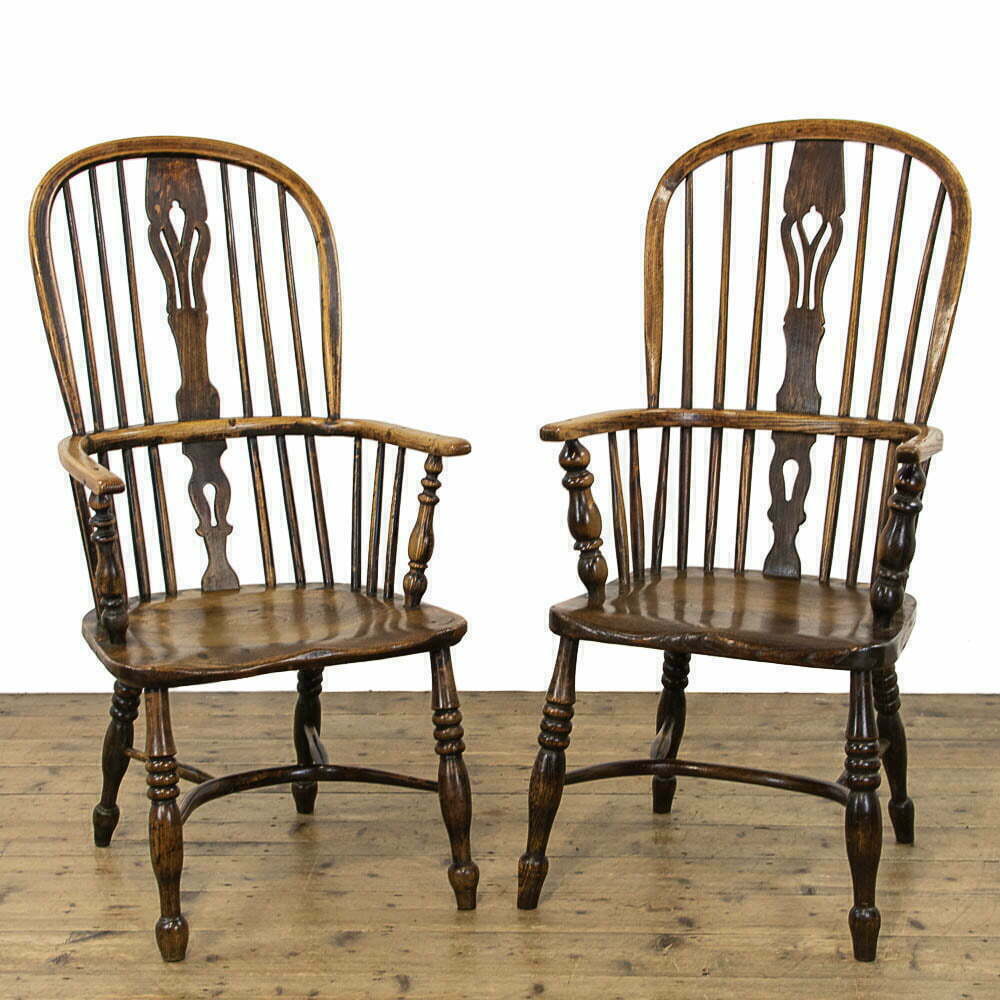All About the Windsor Chair
Introducing the Windsor Chair
The antique Windsor chair stands as an iconic symbol of British craftsmanship and timeless design. Its rich history, rooted in the rural regions of England and Wales, reveals a captivating story of innovation, regional influences, and enduring appeal. In this blog post, we will embark on a journey through time, exploring the development and evolution of antique Windsor chairs, and uncovering the intricate details and craftsmanship that make them cherished pieces in the world of furniture.
Origins and Influences of the Windsor Chair
The exact origins of the Windsor chair remain shrouded in uncertainty. Just like many historical items, there exists a charming – albeit fantastical- narrative. Legend has it that King George III sought refuge from a storm while hunting in Windsor Great Park and found shelter in an unassuming cottage. Enthralled by the unpretentious yet cozy chair offered to him, he instructed the royal cabinetmaker to replicate its design for Windsor Castle. However, historians suggest that it emerged as a development of the West Country, Welsh, and Irish “stick-back” chairs during the 16th century. Wheelwrights of the time began shaping chair spindles akin to the process of crafting wheel spokes, hinting at the early evolution of the Windsor chair design.
The first documented reference to a ‘Windsor’ chair can be traced back to the 1720s, where they were initially employed as outdoor or garden seating. These chairs, painted in a vibrant green hue, were commonly referred to as ‘Forest Chairs.’ Remarkably, Windsor chairs adorned with their original green paint can be observed beneath the portico at West Wycombe Park, the former residence of Sir Francis Dashwood, the founding member of the infamous Hellfire club in the 1700s.
Birthplace and Early Production
While the precise birthplace of the Windsor chair remains elusive, it is believed to have made its first appearance in Buckinghamshire, eventually finding its primary production center in High Wycombe. The comb-back Windsor chairs, featuring a distinctive crest resembling a comb, gained popularity during this period. Interestingly, the town of Windsor, Berkshire, played a significant role in the trade between producers and London dealers, lending its name to this distinctive style.
Craftsmanship Techniques
Crafting an antique Windsor chair required the expertise of three specialized craftsmen. The chair bodger, often an itinerant woodworker, would meticulously shape the legs and stretchers using a traditional pole lathe. The benchman, working in small workshops dotted across the countryside, skillfully crafted the seats, backsplats, and other sawn parts. Finally, the framer, an assembly expert, brought together the various components crafted by the bodger and benchman, skillfully assembling and finishing the chair.
Design Innovations and Techniques
In the 18th century, a groundbreaking technique revolutionized Windsor chair production: steam bending. This innovative method allowed craftsmen to shape the characteristic bow of Windsor chairs by bending wooden pieces using steam. The introduction of steam bending was a significant milestone, as it provided the chairs with their signature curves and added structural integrity. Without this technique, the Windsor chair as we know it today would not have emerged.
Regional Styles of the Windsor Chair
Throughout their history, Windsor chairs have showcased a remarkable diversity of regional styles and unique features. In the Thames Valley region, where Windsor itself was located, chairs often featured cabriole legs, while West Country chairs boasted a distinctive three-part arm bow and a leg form referred to as a “colt’s foot.” Chairs made in Mendlesham, Suffolk, sported rectangular backrests, setting them apart from their counterparts. Classic Welsh examples include this comb-back style, found at the Museum of Wales. The endless combinations of design elements and regional variations make each antique Windsor chair a truly individual work of art.
Enduring Appeal and Collectibility
The enduring allure of antique Windsor chairs can be attributed to their elegant simplicity, durability, and versatility. The Windsor chair serves as an excellent choice for seating at any dining table or as an armchair, providing both comfort and aesthetic appeal. Its spacious seat, complemented by a well-calibrated slant, contributes to its exceptional comfort. In addition to their pleasing visual appearance, Windsor chairs are widely regarded as one of the most comfortable chair designs. With their tall backs offering excellent back support, they are perfect for unwinding and relaxation. The contours of the chair seat beautifully mimic the shape of the human posterior. Jim Steele has been making Windsor chairs by hand for a quarter of a century. In an interview with Country Life’s Tessa Waugh, he said:
‘With the Windsor chair, there aren’t straight or square lines, they’re all ergonomic and that’s what fascinates me, that you can sit in a wooden chair and feel lovely and comfortable. They just wrap themselves around you.’
These chairs were not only easy to manufacture but also lightweight and portable, making them popular choices for both indoor and outdoor settings. Their timeless design has stood the test of time, and today, Windsor chairs continue to be cherished by collectors and homeowners alike. From simple slat-backed chairs to elaborate gothic-inspired designs, Windsor chairs offer a wide range of options for discerning collectors and those seeking classic pieces for their homes.
Conclusion
The evolution of antique Windsor chairs in England and Wales showcases the ingenuity and craftsmanship of generations of skilled artisans. From their mysterious origins and early production centers to the diverse regional styles and innovative techniques, each Windsor chair tells a unique story. As these chairs continue to capture the hearts of collectors and enthusiasts worldwide, their legacy as iconic symbols of British furniture design remains unshakable.
At Penderyn Antiques we always keep a wide range of Windsor chairs in stock, in different styles and from different eras. You can shop our range of Windsor chairs on our Penderyn Antiques website here. If you have any questions, or if you’re looking for a particular size or style then please get in touch with us here, we’re always happy to help!



